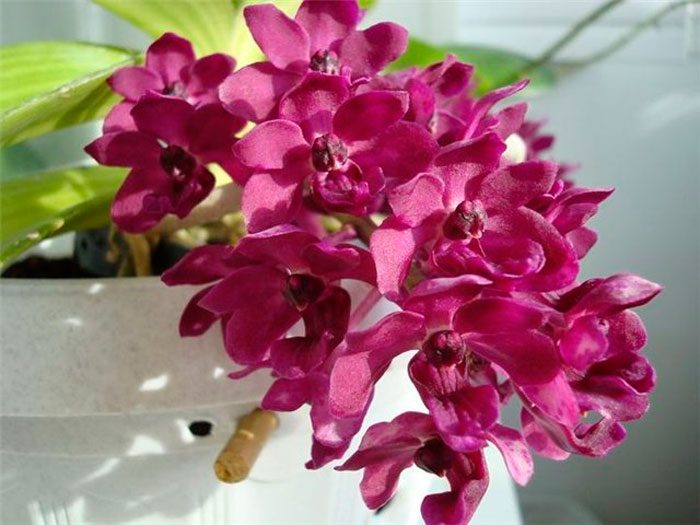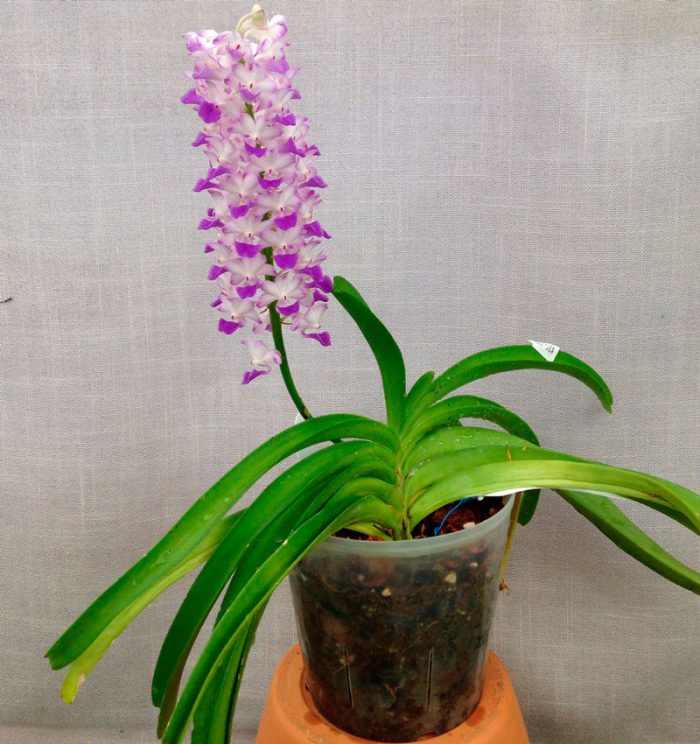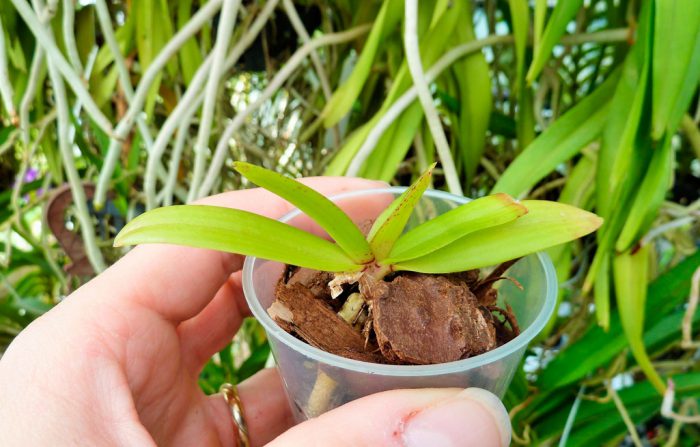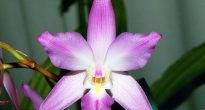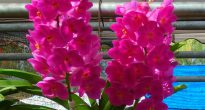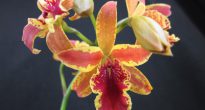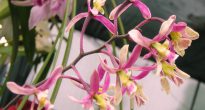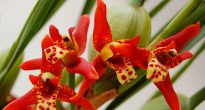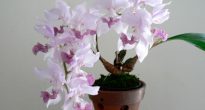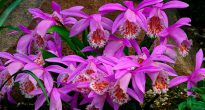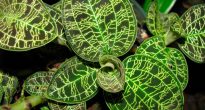A small genus of Rhynchostylis (Rhynchostylis) is directly related to the orchid family. It unites only 6 plant species. In natural conditions, they can be found in Indonesia, Southeast Asia, and also in the Philippines.
This plant has a monopodial growth pattern, which means that at all times it grows only one vertically located stem. In the process of growth, the leaves on the bottom die off and fall off, while strong aerial roots grow from the remaining leaf sinuses, on the surface of which there is a fairly thick layer of porous velamen. Alternate, dark green, vaginal leaves on the shoot sit quite tightly. Thick, hard, almost succulent leaves have a belt-like shape, while their tip is not very even, as if chopped off. From the leaf sinuses below, peduncles grow, which bear multi-flowered inflorescences, which are quite large clusters. Small fragrant flowers are round in shape, and they are no more than 2 centimeters in diameter. The 3 sepals (sepals) are very similar to the petals and have a wide oval shape. Sepals are located relative to each other at an angle of 120 degrees. 2 true petals (petals) lie opposite each other, while they are not as long and wide as sepals, although they have the same color. The lip with a contrasting color (3rd true petal) has the same size as the petals, but at the same time it is bent perpendicular to the calyx. The lip has a spatulate shape, while its edge is dissected or crenate. This genus was named Rhynchostilis because of its beak-shaped column (reproductive organ). So, rhynchos is translated from Greek as "beak".
Caring for the rhynchostilis orchid at home
This plant does not differ in undemanding care. In order for it to grow and develop normally, it is necessary to constantly maintain a certain temperature, humidity and illumination.
Illumination
Such an orchid is photophilous and it is recommended to place it in a sunny place. However, it should be shaded from the scorching midday direct rays of the sun to prevent burns on the surface of the leaves.If the lighting is too bright, then the leaves change their color to reddish, after the flower is removed in the shade, they turn green again. If there is little light, then the foliage turns dark green.
In order for flower stalks to form, you need not only bright lighting. Also, the duration of daylight plays an equally important role. So, all year round it should be from 10 to 12 hours. In this regard, in autumn and winter, rhynchostilis needs to be illuminated with phytolamps.
Temperature regime
This plant must be provided with a moderately warm temperature regime. Moreover, it needs changes in daily temperatures. During the day it should be from 22 to 28 degrees, and at night - from 17 to 20 degrees. It should be noted that the difference in daily temperatures should have a difference of approximately 5 degrees.
Earth mixture
This orchid does not need a substrate. It grows on a block with open roots. As a rule, the block is made from a large piece of pine bark, on which the roots and base of the stem are fixed. You can also use lattice baskets made of plastic or wood. The roots should pass freely through the holes in the walls.
How to water
Watering is carried out by immersing the root system in a basin filled with soft and always lukewarm (from 30 to 40 degrees) water. After the leaf sinuses have been thoroughly dried (if necessary, all the liquid must be removed from them), the plant must be placed in its usual place. This should be done to prevent the formation of rot on the base of the leaves.
Humidity
High humidity is required. So, the humidity in the room should be at least 60–65 percent. To do this, it is necessary to ensure systematic frequent spraying, and it is also just necessary to use a household steam generator, while the air stream must be directed to the roots.
Fertilizer
Fertilize the plant from March to November. Top dressing is carried out 1 time in 2 or 3 weeks, while using special fertilizers for orchids (take ½ part of the dose recommended on the pack). The fertilizer should be diluted in water intended to moisten or water the plant.
Being on the street
Being in the fresh air, such an orchid will be provided with the optimal temperature regime with the necessary temperature differences during the day, but at the same time, you need to choose a place with very high air humidity for it.
Dormant period
The plant can bloom in any of the months, while it does not need a rest period.
Reproduction methods
When grown indoors, this flower cannot be propagated. By a happy coincidence, a baby can form on the escape. It can be carefully separated from the mother plant only after its roots have fully formed.
In industrial conditions, rhynchostilis is grown meristemally (cloning) or from seed.
Pests and diseases
Resistant to pests. Often, rot may appear on the flower as a result of waterlogging, or its roots dry out due to low humidity.
Also, the plant may not bloom. This is due to many reasons related to violations of the rules of care. As a rule, this is observed due to low humidity and poor illumination.
Video review
Main types
In Russia, only 2 species are popular with orchid growers.
Rhynchostylis giant (Rhynchostylis gigantea)
This epiphyte is large enough. The fleshy leaves are 30 to 40 centimeters long and 5 to 6 centimeters wide. The plant blooms in autumn-winter for 10-14 days. Dense inflorescences are attached to the peduncle, in shape similar to a cylinder and reaching no more than 40 centimeters in length. These inflorescences consist of 20-60 small (about 2.5 centimeters in diameter) flowers, which have a small spur at the back.Sepals and petals are narrowed at the base, as a result of which there is a rather large gap between them. The three-lobed lip has strongly raised lateral lobes.
There are 2 different forms of this type of orchid. One has snow-white flowers, and the other is white, but there are purple-pink spots on the petals and sepals and the lip is painted in the same color shade as the spots.
Blunted Rhynchostylis (Rhynchostylis retusa)
This epiphyte is of medium size. The leaves of this species are smaller than those described above, however, the peduncle is somewhat longer (about 60 centimeters), and in the inflorescences there are up to 100 small (no more than 2 centimeters in diameter) flowers. 2 large sepals, located below, have a broad-oval, almost round shape. Moreover, the third sepal, located above, is not so wide and large. Narrow petals are superimposed on sepals, while they cover them, as a result of which a solid cup is formed. Light pink flowers have small dots of dark pink color. The lip is also dark pink. Blooms in late winter early spring.

